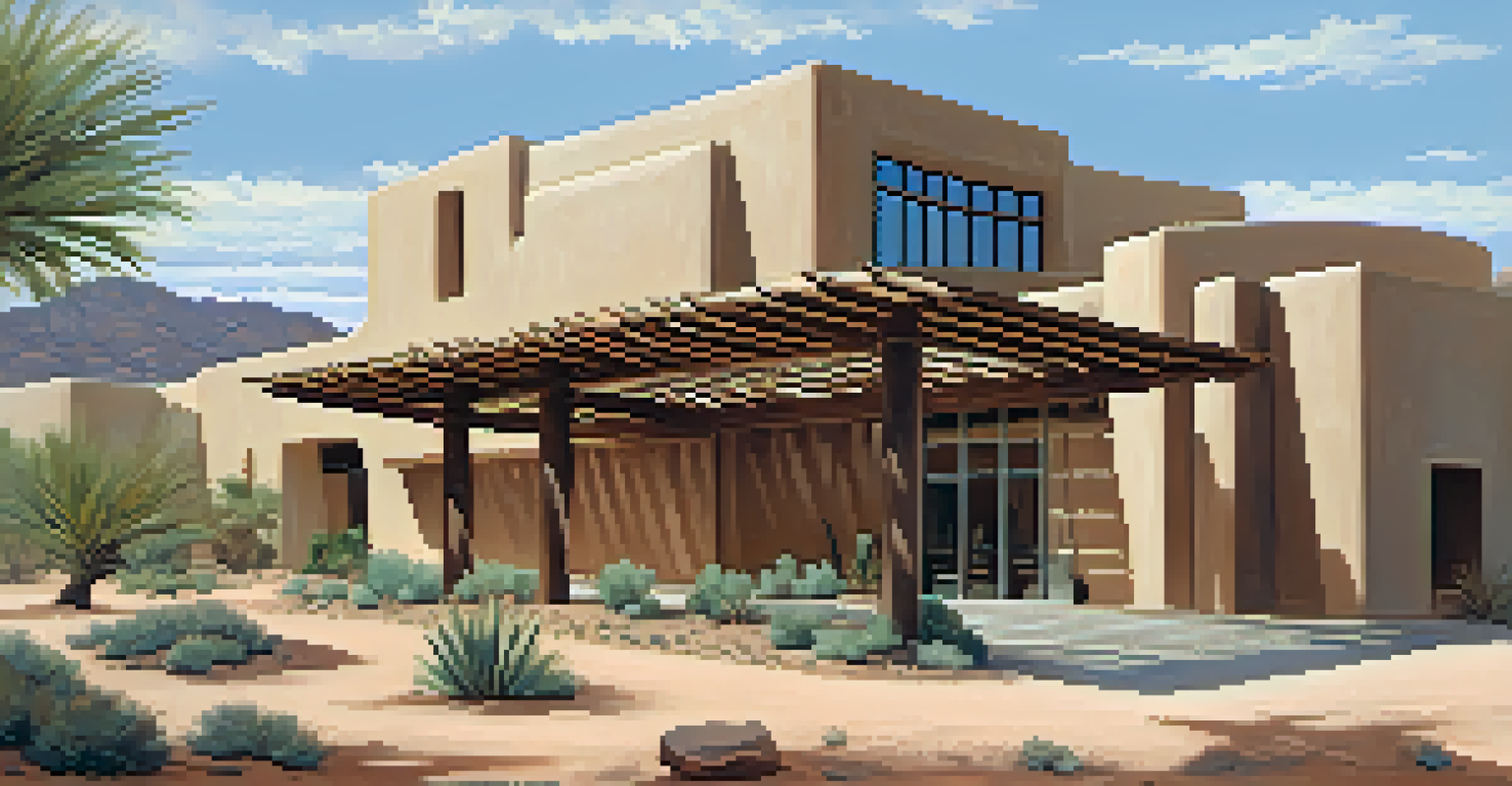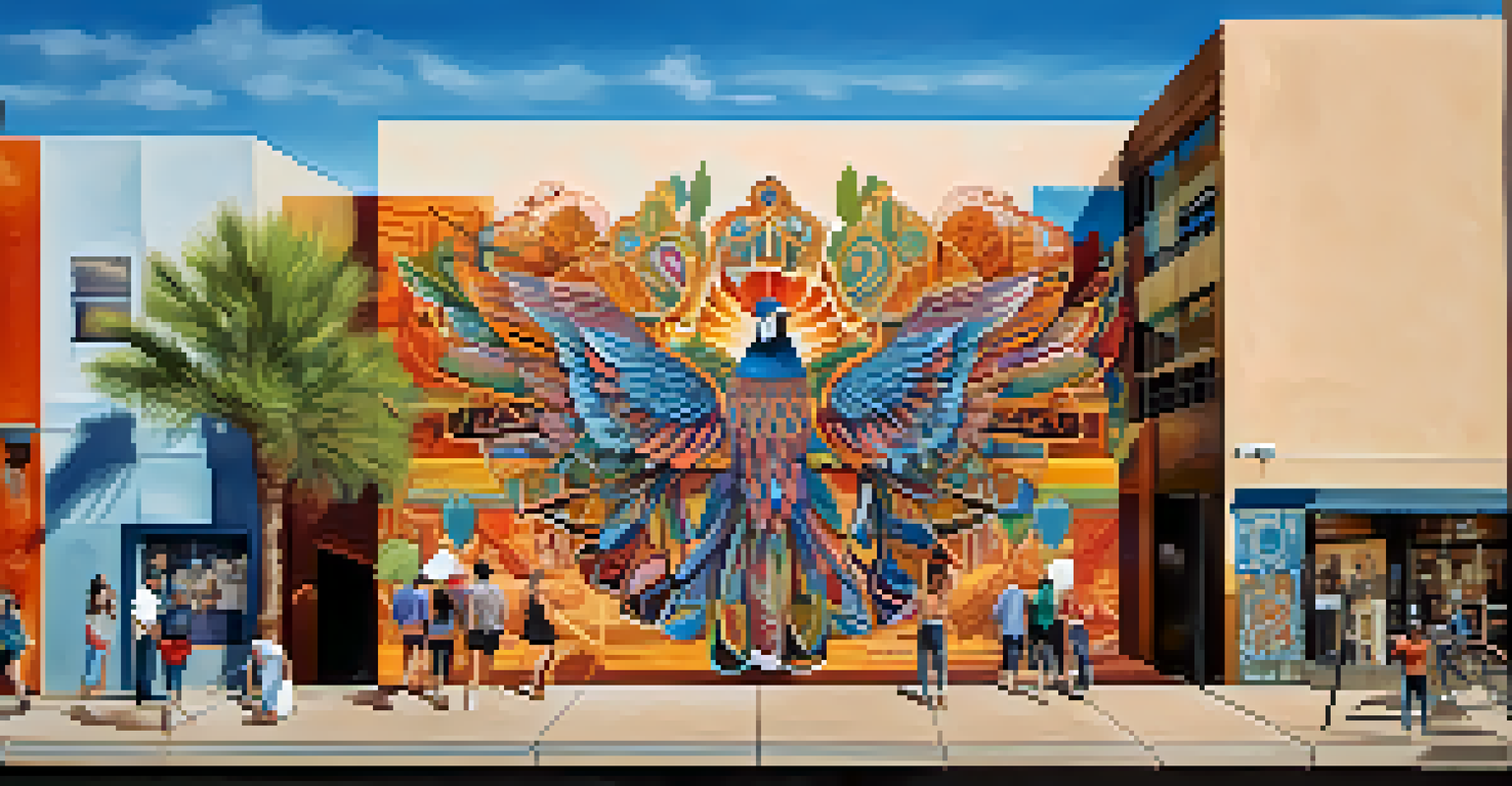The Architectural Wonders of Phoenix: Art Meets History

The Rich History Behind Phoenix's Architecture
Phoenix's architecture tells a story that spans centuries. Founded in the late 19th century, the city has evolved from a humble agricultural community into a sprawling metropolis. Each building reflects the cultural influences and historical events that have shaped the area, making it a living museum of architectural styles.
Architecture is the learned game, correct and magnificent, of forms assembled in the light.
From the adobe structures of the early settlers to the modern skyscrapers that define the skyline today, every era has left its mark. For instance, the iconic Heard Museum showcases not just Native American art but also the architectural style that pays homage to indigenous cultures. This blend of history and design creates a rich tapestry that visitors and locals alike can appreciate.
Understanding this historical context enhances our appreciation of Phoenix's architecture. It’s not just about aesthetics; it’s about the stories and the people behind these structures, which makes exploring the city all the more intriguing.
Mid-Century Modernism: A Phoenix Staple
One of the standout architectural movements in Phoenix is Mid-Century Modernism. This style, popular from the 1940s to the 1960s, emphasizes clean lines, organic forms, and a strong connection to nature. In Phoenix, this movement has been embraced enthusiastically, leading to some stunning residential and commercial buildings.

Take a stroll through neighborhoods like Arcadia, where you can find beautifully preserved Mid-Century homes that boast large glass windows and open spaces. These designs invite the outdoors in, creating a harmonious living environment that resonates with the region's natural beauty. The iconic Arizona Biltmore Hotel is another prime example, blending luxury with the Mid-Century ethos.
Phoenix's Architectural Evolution
The city's architecture reflects a rich history, showcasing influences from various cultures and historical events.
This architectural style not only reflects a specific era but also influences contemporary design in Phoenix. Many modern architects draw inspiration from these principles, ensuring that Mid-Century Modernism remains a vital part of the city’s architectural identity.
The Influence of Native American Architecture
Native American architecture has played a crucial role in shaping Phoenix's built environment. The region's indigenous peoples have a long history of creating structures that are in harmony with the land, using local materials and traditional techniques. This influence can be seen in several buildings throughout the city.
The best architecture is the one that comes from the heart and speaks to the soul.
One notable example is the Heard Museum, which not only showcases Native American art but also incorporates elements of indigenous architecture. The use of natural materials and earth tones in its design reflects a deep respect for the environment and cultural heritage. Additionally, the museum's layout encourages visitors to engage with the landscape, reminiscent of traditional native practices.
By blending these architectural influences, Phoenix honors its past while creating spaces that resonate with contemporary values. This connection to Native American architecture enriches the city's cultural narrative, reminding us of the importance of sustainability and community.
Sustainable Architecture in Phoenix
As environmental awareness grows, Phoenix has become a leader in sustainable architecture. With its unique climate, architects are designing buildings that not only minimize environmental impact but also enhance energy efficiency. This focus on sustainability is reshaping the city’s landscape for the better.
For instance, the Desert Botanical Garden showcases how buildings can harmonize with their surroundings. Structures within the garden use passive solar design and native materials to reduce energy consumption and blend seamlessly with the desert environment. This approach not only preserves natural resources but also educates visitors about sustainable practices.
Embrace of Sustainable Design
Phoenix is leading the way in sustainable architecture, focusing on energy efficiency and environmental harmony.
By prioritizing sustainability, Phoenix is paving the way for future architectural innovations. Architects and builders are increasingly adopting green technologies, making the city a model for balancing development with ecological responsibility.
Iconic Landmarks: The Heart of Phoenix
Phoenix is home to several iconic landmarks that capture the city's architectural spirit. The Arizona State Capitol, with its distinctive copper dome, stands as a testament to the state's rich history and governance. This building not only serves as a functional space but also as a symbol of pride for the residents.
Another landmark, the Frank Lloyd Wright-designed Taliesin West, is a masterpiece of organic architecture. Nestled in the foothills of the McDowell Mountains, it reflects Wright's philosophy of blending structures with their environment. Visitors are often in awe of how the building's design mirrors the natural landscape, showcasing the seamless connection between art and nature.
These landmarks do more than just adorn the skyline; they tell stories of the past and inspire future generations. Each structure invites exploration and reflection, embodying the spirit of Phoenix and its commitment to preserving its architectural heritage.
The Role of Art in Phoenix's Architecture
Art and architecture are deeply intertwined in Phoenix, creating spaces that are not only functional but also visually captivating. Public art installations, murals, and sculptures enhance the architectural landscape, making the city an open-air gallery. This integration of art adds vibrancy and character to urban spaces.
The downtown area is particularly rich in artistic expression, where buildings are adorned with colorful murals that tell stories of the community. These artistic elements invite engagement and conversation, encouraging residents and visitors to appreciate art in everyday life. The Phoenix Art Museum itself is an architectural gem, offering both a stunning collection and a beautiful space to explore.
Art Enhances Urban Spaces
Public art and architecture in Phoenix create vibrant, engaging environments that celebrate community and culture.
By embracing art in architecture, Phoenix fosters a creative environment that celebrates individuality and cultural diversity. This synergy not only beautifies the city but also strengthens community ties, making Phoenix a unique and welcoming place.
Preserving Architectural Heritage in Phoenix
As Phoenix continues to grow, preserving its architectural heritage becomes increasingly important. Historical buildings provide a sense of identity and continuity, reminding us of the city's journey. Organizations and initiatives are dedicated to protecting these structures, ensuring that future generations can appreciate their historical significance.
The Phoenix Historic Preservation Commission plays a vital role in safeguarding the city’s architectural treasures. They work to identify and designate landmarks, helping to maintain the character of historic neighborhoods. This commitment to preservation not only honors the past but also enriches the urban landscape with unique stories.

By valuing and preserving architectural heritage, Phoenix creates a bridge between history and modernity. This preservation efforts foster a sense of belonging and pride among residents, making the city not just a place to live, but a community steeped in rich cultural history.